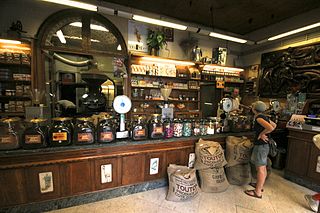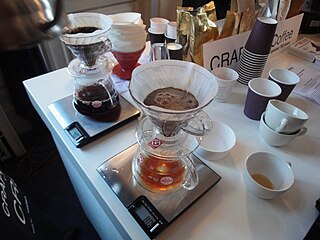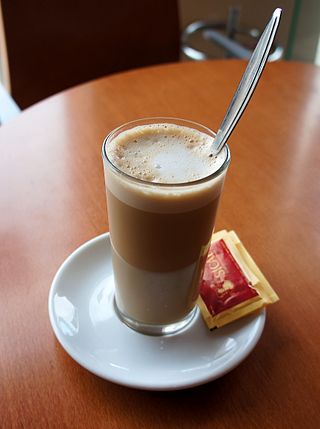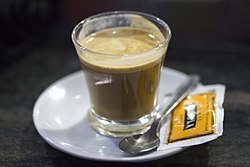
A cappuccino is an espresso-based coffee drink that is traditionally prepared with steamed milk including a layer of milk foam.

Espresso is a coffee-brewing method in which a small amount of nearly boiling water is forced under pressure through finely ground coffee beans.

Italians are well known for their special attention to the preparation, the selection of the blends, and the use of accessories when creating many types of coffees. Many of the types of coffee preparation known today also have their roots here. The main coffee port in Italy is Trieste where there is also a lot of coffee processing industry. Italian coffee consumption, often espresso, is highest in the city of Trieste, with an average of 1500 cups of coffee per person per year. That is about twice as much as is usually drunk in Italy.

A barista is a person, usually a coffeehouse employee, who prepares and serves espresso-based coffee drinks and other beverages.

Caffè latte, often shortened to just latte in English, is a coffee drink of Italian origin made with espresso and steamed milk, traditionally served in a glass. Variants include the chocolate-flavored mocha or replacing the coffee with another beverage base such as masala chai, mate, matcha, turmeric or rooibos; alternatives to milk, such as soy milk, almond milk or oat milk, are also used.

Caffè macchiato, sometimes called espresso macchiato, is an espresso coffee drink with a small amount of milk, usually foamed. In Italian, macchiato means 'stained' or 'spotted', so the literal translation of caffè macchiato is 'stained coffee' or 'marked coffee'.

Ristretto is a "short shot" of a more highly concentrated espresso coffee. It is made with the same amount of ground coffee, but extracted with a finer grind using half as much water. A normal short shot might look like a ristretto, but in reality, would only be a weaker, more diluted, shot. The opposite of a ristretto is a lungo ('long'), which has double the amount of water. The French call a ristretto a café serré.

Café au lait is coffee with hot milk added. It differs from white coffee, which is coffee with cold milk or other whiteners added.

A coffee cup is a container, a cup, for serving coffee and coffee-based drinks. There are three major types: conventional cups used with saucers, mugs used without saucers, and disposable cups. Cups and mugs generally have a handle. Disposable paper cups used for take-out sometimes have fold-out handles, but are more often used with an insulating coffee cup sleeve.

Latte macchiato is a coffee beverage. The name is Italian for 'stained milk' or 'marked milk', referring to the way the drink is prepared by pouring a shot of espresso into steamed milk. It is a play on espresso macchiato, an older drink consisting of espresso marked with a dollop or two of milk or cream.

A flat white is a coffee drink consisting of espresso and steamed milk. It generally has a higher proportion of espresso to milk than a caffè latte, and lacks the thick layer of foam in a cappuccino. While the origin of the flat white is unclear, various café owners in Australia and New Zealand claim its invention.

Café Cubano is a type of espresso that originated in Cuba. Specifically, it refers to an espresso shot which is sweetened. However, the name is sometimes used to refer to coffee based drinks that include Cuban espresso as the main ingredient, such as café con leche.

Microfoam is finely textured milk used for making espresso-based coffee drinks, particularly those with latte art. It is typically made with the steam wand of an espresso machine, which pumps steam into a pitcher of milk.

Café con leche is a coffee beverage common throughout Spain and Latin America consisting of strong coffee mixed with scalded milk in approximately equal amounts. The amount of milk can be higher in a café con leche en vaso or a café con leche de desayuno. Cuban and Puerto Rican establishments often prepare the drink with sugar. Sugar or sweetener is added to taste. It is similar to the Italian caffè latte and the French café au lait.

Coffee preparation is the process of turning coffee beans into liquid coffee. While the particular steps vary with the type of coffee and with the raw materials, the process includes four basic steps: raw coffee beans must be roasted, the roasted coffee beans must then be ground, and the ground coffee must then be mixed with hot or cold water for a specific time (brewed), the liquid coffee extraction must be separated from the used grounds, and finally, if desired, the extracted coffee is combined with other elements of the desired beverage, such as sweeteners, dairy products, dairy alternatives, or toppings.

Milk coffee is a category of coffee-based drinks made with milk. Johan Nieuhof, the Dutch ambassador to China, is credited as the first person to drink coffee with milk when he experimented with it around 1660.

Caffè americano, also known as americano or American, is a type of coffee drink prepared by diluting an espresso shot with hot water at a 1:3 to 1:4 ratio, resulting in a drink that retains the complex flavors of espresso, but in a lighter way. Its strength varies with the number of shots of espresso and the amount of water added. The name is also spelled with varying capitalization and use of diacritics: e.g., "café americano".

Galão is a hot drink from Portugal made by adding foamed milk to espresso coffee. Similar to caffè latte or café au lait, it consists of about one quarter coffee and three quarters foamed milk. It is served in a tall glass, as opposed to the smaller garoto that is served in a demitasse. When the proportion is 1:1 it is called meia de leite and it comes in a cup.
Countries have cultivated coffee beans into various vehicles to satisfy needs unique to each country. Whether it be for energy, socialization, or tradition, the cultivation of coffee has served as a motivating force of the world. The modernization of coffee and its unique forms across cultures are markers of tradition and modern changes across continents. Coffee culture appears in the way in which people consume coffee, the way they make it, and where coffee is served and shared. Each of these factors combined reflects the lives of the people in these countries and the importance of coffee across the world.




















